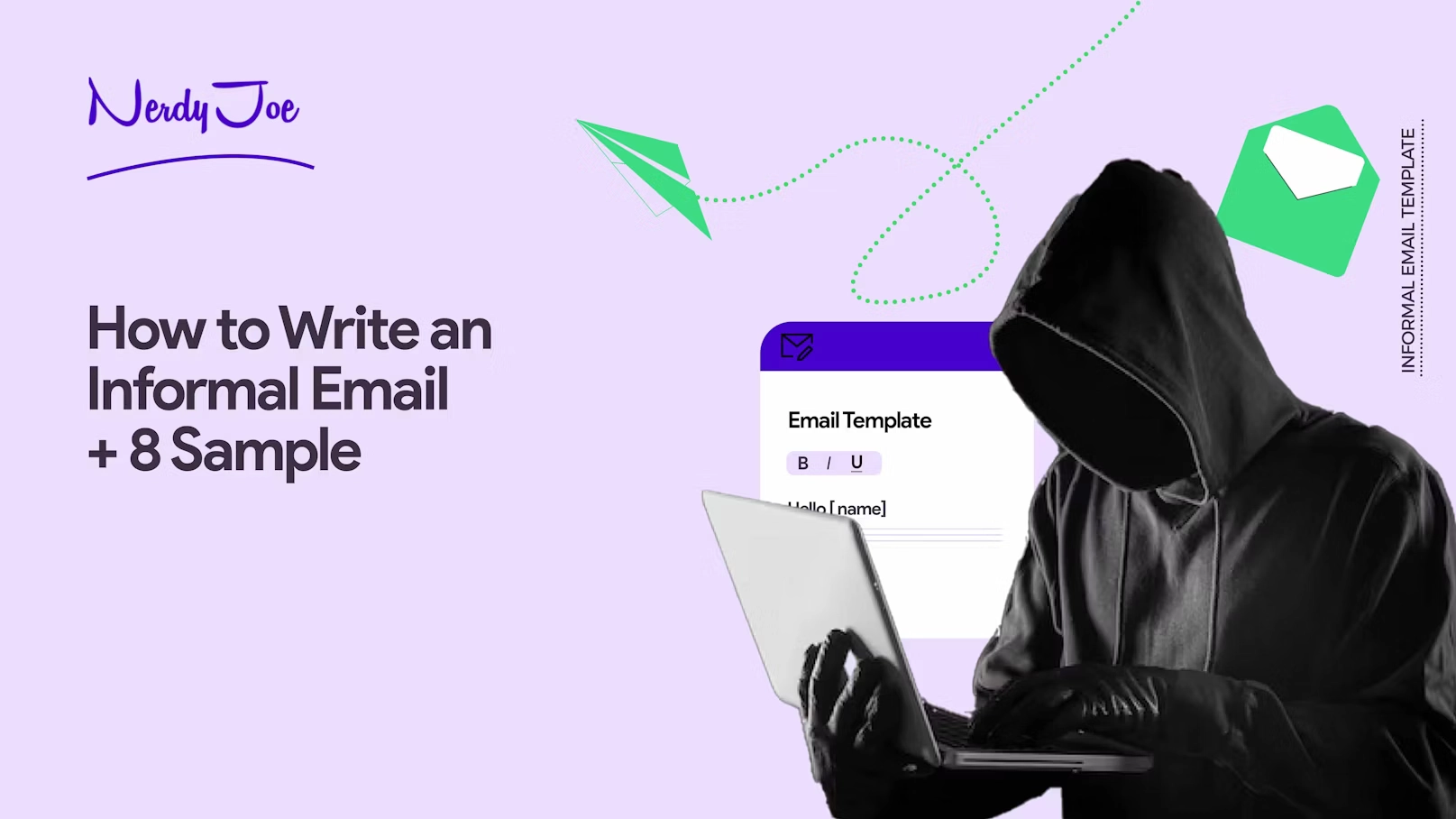Getting leads for your digital marketing agency is one of the most challenging experiences every digital marketer has to go through.
For our little experiment, when we were trying to get leads for our content writing agency, we used cold email as our primary strategy and communication channel with potential leads.
The strategy proved to be complex, but the result we had was quite excellent. Long story short, we were able to close companies such as Fondationinc.co, Ahrefs, AppSumo, Hunter.io, Vidico, and more.
Here’s an overview of our results or responses after our cold email campaign.
Here is the answer we got from Hunter.io’s Irina.

How we closed Ross Simmonds, founder of FoundationInc.

Here is another successful example.

These are just a few of the positive responses we’ve gotten. We can show you plenty of others, but that’s not really the point.
This article aims to show you how you can generate leads for your digital marketing agency with cold email — and the lead generation process we use to do it. First, we will start with some prerequisites to ensure your success.
Note: Wanna fill your digital marketing agency’s pipeline with more leads and need a team to help you effectively run outbound marketing campaigns? We will help you get 6 meetings per month at $999. Grab your deal here.
4 things you need to nail right to guarantee your success
Working for a B2B company as a digital marketing company or agency is quite multifaceted.
Before we discuss the strategy you can use to get leads, let’s first outline some prerequisites you need to get right to differentiate yourself from the competition and get the attention of your prospective businesses.
Have a niche
It’s only natural that companies would want to work with a digital marketing agency with experience in their industry.
Having a niche focus results in the company identifying with you better and being much more willing to work with you.
There are other reasons for this as well. For example, niching down makes your service relevant to specific companies who see your service as the best for their needs and see you as the best expert on the market for them.
Niching down also implies some experience in a specific field or market and makes people trust you more easily.
So, do you serve SaaS companies? E-commerce? Government companies? Fortune 500 companies? Companies that sell a specific type of product?
Also, having a niche is about specializing in one specific activity. You do digital marketing, cool. But that doesn’t mean that you have to offer social media marketing services, Facebook lead ads, etc.
Many marketing agencies do this. But we think it’s best and far more valuable if you offer only one service that you truly master and perform well.
Sell a strategy and know how to wrap it
You are a digital marketing agency; chances are you know at least 10 teams that can do the same work as you.
Also, in most cases, depending on the service you offer (SEO, Content Marketing, PR, Cold email, etc.), your service will revolve around content creation and outreach campaigns, or it will be a set of activities you perform routinely.
So, it won’t be easy to get people to buy such activities because anyone can do it, and it doesn’t seem like something with a significant business value as it is. In our experience, it will be much easier for you to sell your service as a bundled strategy with a specific outcome for your target company will be much easier.
You always have to assume that the B2B company you’re trying to work for can hire someone in-house to do the work, so what you want to sell has to be much more of an outcome-oriented strategy or service.
For example, at Nerdy Joe, we don’t sell cold emails or just email campaigns; instead, we sell a strategy or a marketing outcome that allows us to do super-personalized cold emails and bring ready-to-buy customers for your sales team to close.
As such, we are not just another cold email company; we help our clients get leads that are ready to buy. Framing our offer from this angle is much more ideal and has much more value to the target companies.
Have a unique value proposition
Take Grow and Convert, for example. Their unique value proposition is that they don’t believe in top-of-the-funnel, volume-driven keyword content marketing strategies. They believe much more in creating business interaction-oriented content for their customers.
And they explain it well by showing how going after keywords just because they have high search volumes doesn’t help companies generate business but instead gets them in front of prospects who aren’t ready to buy.
On the other hand, the focus on keywords that have commercial and transactional value helps the company to make money because the content is positioned to convert the reader.
Or, we, Nerdy Joe, for example, believe in sending very few emails and getting results instead of purchasing and targeting huge lists.
Most cold email marketers or specialists approach it as a number game. They believe in scenarios like sending 500 cold emails per day, 2500 per week and converting at least 0.5% of them.
The problem is that this process is messy and spammy, and that’s not how brands want to be represented.
Companies don’t want to appear as spammers and damage their online reputation because a marketer wants to send 500 emails to random people per day.
So, the idea here is to have an idea or philosophy that differentiates you from most competitors in the market. As we’ve established earlier, several companies, teams, or individuals can probably do your job.
But your approach, your philosophy, your way of doing things, and your unique value are the elements that will allow you to differentiate yourself and really prove the value and effectiveness of your service to the prospective company.
Get ready to impress
With most of the B2B companies you want to work for, the typical scenario is that these companies will already have an internal team doing marketing for them.
They already have a team, a strategy, a plan, and people already doing the work for them.
So when you’re trying to win them as a customer, your job is to either help them execute what they already have in place or bring new ideas, strategies, or approaches that promise better results or specific outcomes.
That being said, if you are doing outreach, your message, for the most part, will have to be addressed to the company’s marketer.
And even if you send your message to someone outside the marketing department and in a higher hierarchy, you can be sure that the person will refer you to the marketing department.
This has happened a few times with us. For example, with Ahrefs, we tried to email the CEO, who added Joshua Hardwick to the conversation and asked us to continue the conversation with him.
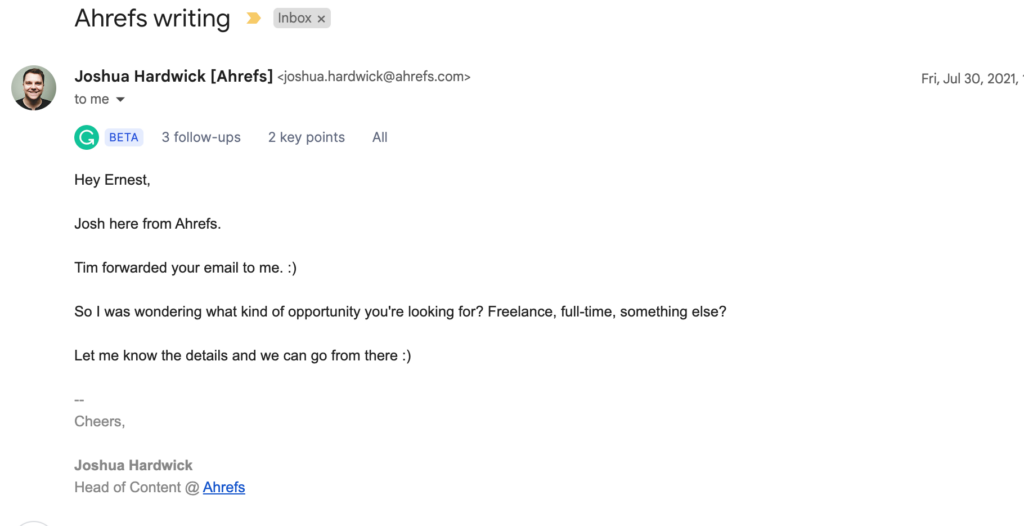
The same thing happened with Lemlist, where we sent the message to Guillaume, who loved our email, then added Vuk (the CMO at the time) to the conversation and asked him to talk with us.

Having said that, we can tell you right now that it is never easy to get a marketing job from marketers. It’s hard to convince another marketer, and you’ll have to impress or beat their ego before making it through the door.
Your lead generation strategy will come down to impressing the other marketers so they can hire you to either do their job, contribute to their job or do something specific on the side.
We know how marketers think in general, and we have taken the time to master how to send them cold emails, so they like it.
You’ll notice that most of their responses to our emails start with words of appreciation for our work and tell us how they liked our emails.
Here are some examples. Here is Ross’ example.

Here is another example.

Another one.

You’ll notice that after they tell us they liked the email and what we offer, they offer to work with us immediately.
That’s the “impression” we’re talking about. When you manage to impress them, they are much more likely to want to work with you.
7 steps to generate leads for your digital marketing agency using cold email
There are many lead generation strategies and channels you can use to generate leads for your digital marketing agency. You can use inbound marketing as well as outbound marketing.
We primarily use cold email marketing (i.e., outbound marketing). We believe outbound cold emails give your brand a channel you can own to control who you reach out to compared to inbound marketing techniques.
Here are the steps we typically follow to generate B2B leads for ourselves and the digital agencies that decide to work with us.
Step 1: Understand your target company’s product and brand
This is more of a common courtesy — because you can’t possibly reach out to a company offering to do marketing for them without really knowing what product they sell, what it does, their target audience, and how they present their brand to their outer world.
Understanding these is how you can devise an effective marketing and business strategy that aligns with the company and everything they already do and stand for. Here is how you can approach this.
Company product
Start by researching the features and benefits of the product. Look for information about how the product is made, what problems it solves, and what makes it unique compared to similar products in the market.
Try to understand how the product is used and how it fits into the customer’s life. You can also try finding answers to the following questions:
- What pain point is the product or service solving?
- What situations are users avoiding by using the product or service?
- What happens to the users when they don’t solve the problem?
Target audience
Research the demographics and psychographics of the typical customer of your target company.
Demographics should include factors like age, gender, income, and education level, while psychographics should cover factors like values, attitudes, and lifestyle.
Look for information about where the target audience spends their time, what they care about, and what motivates them to purchase.
On top of that, you can go deeper to understand the users and how they engage with the company. The following questions might help:
- Which prospects are the easiest to close for the company?
- Which are the hardest to close?
- What’s their lead-to-close rate?
- Which type of client has the highest lifetime value? Why?
- Which type of client churns the fastest?
The answer to these questions will help you pick up patterns on how the company’s target audience typically engages with the company’s marketing materials and the average success rate they get.
This information can be useful and help you be more realistic in what results you promise the brand.
Company brand
Here, start by researching the company’s messaging, visual identity, and tone of voice. Look for information about what the company stands for, what makes it unique, and what sets it apart from competitors.
Try to understand the emotions the brand evokes in its customers and how it is perceived in the market.
This can help you learn how they want their company to be presented to their target audience and how they speak to them.
You can use this data in your outreach cold emails to demonstrate how you will present your brand under its best lights. You can learn what makes the brand unique and suggest approaches to beat the competition.
Step 2: Determine ICPs, score leads and qualify them
This step involves research, market segmentation, and persona creation. Basically, you’ll have to determine companies that are likely to be interested in the services you are offering.
You certainly have some idea about who your ideal customer is. The problem with this step is that most digital marketers or digital marketing agencies get their ICPs wrong. We can see how easy it is to think that you should target any company that cries for digital marketers.
But in our experience, that’s not the best way to find the best company to work with. Generally, when asked what’s their ICPs, digital marketing agencies owners reply something along the lines of:
- Our ICP is SaaS companies
- We work with eCommerce businesses
- We are targeting tech companies
For some of them, that like to be a little more specific. They come with answers such as:
- Our ICP is a B2B SaaS company that recently had an IPO
- Our ICP is man fashion e-commerce businesses
You can think that you’ll be able to be hired by all these companies and do a good job, but no.
Also, that’s not any quality data to run a highly targeted and personalized campaign. You can get more specific about what companies you offer your services to, and you need to.
We have a couple of questions we think you can try answering to get to the bottom of that.
Here are the questions.
- What’s the story behind your company?
- What type of pain points are you trying to solve through your digital marketing agency?
- What’s your marketing philosophy?
- What companies fit key characteristics you care about? (company size, industry, location, revenue, and marketing budget)
These questions will help you really understand who to work with, which type of companies will be the most beneficial to yours, and which customers you shouldn’t go after.
In other words, the answers to these questions will help you know precisely who to target and WHY.
The data you collect here makes the difference between:
“We’re working with series A tech companies,”
And
“Our ICP is a B2B startup company that sells a B2B software to HR professionals, and its main pain points are lack of an outbound marketing strategy, long sales cycles, and little customer lifetime value.
They often refer to XYZ podcasts to get insights as to how to improve their sales cycle and get more customers.”
Once we clearly understand who the ICP is, we manually build our list, which we use to run our lead generation campaigns.
Step 3: Manually research recipients and build your list of leads
At this stage, you’ve already pinpointed the companies you’ll want to target for your marketing services.
Now, you’ll need a specific person or job position to which you’ll reach out to those companies to get your message across.
Hence, the first step is to manually compile a list of the possible recipients for each company you want to target, including names, job titles, and email addresses.
Since you are looking to offer your digital marketing services, we recommend that you reach out to positions like:
- Chief Marketing Officer,
- Content Marketing Officer,
- Head of Marketing,
- Head of Content,
- VP of Marketing,
- Content Marketing,
- and other positions that suggest that the person is either a marketer or leads the marketing department.
Here is how to find the person to reach out to at each company.
Using the company’s website
The best place to find the people working at a company is on their website. Head over to their team, about page, or career page and find the best position to reach out to for your needs.
Go to the site. Scroll down to the lower fold of the page. Ideally, you are looking for these keywords:
- Company
- About
- Team
- Career
- People
Let’s take Encharge.io, for example.

Then go to the page to see the team and find the person you seek.

Using their blog
Sometimes, the company might not have a team page on its website to list the people working there and their different titles. An alternative tactic is to look at the company’s blog.
Here, you want to find the name that publishes the most content on the blog. The person who has the most content on their name is likely to be the head of the content team.
And even if they are not, they are still the right person to reach out to because they can easily link you up with the manager you’re looking for. Let’s take the Foundationinc.co blog as an example here.

Clearly, you’ll have a good chance of being heard if you reach out to Ross Simmonds.
Using LinkedIn
Go to your target website’s profile on LinkedIn and head over to their employee section to search for the position you are looking for to find the name you need. Suppose we are targeting SEMrush.
Step one, going to SEMrush’s profile on LinkedIn.

Step two, click on “Employees” or “People” to find the people working there.

Now you want to search for the keywords we mentioned earlier.

Here is the result.

Find their email address using Hunter’s Email Finder
You’ve got your target’s name and the company they work for. Go to Hunter’s Email Finder to find their email address easily.

Suppose your target’s name is Ibrahim Litinine, and they’re at Nerdy Joe (nerdyjoe.com). Hit the find button and get the email address.

Here’s the result.

Note: If you can’t find the email address this way, we share more tactics for finding someone’s email address here.
Now, you might wonder. Why manually build lists when a simple data intelligence tool such as ZoomInfo can collect all the data? Well, we do this for a couple of reasons.
- Trust: Purchased lists or data intelligence tools may not always provide the accuracy and relevance that a marketing business requires.
- Data quality: We believe in building customer lists manually because it gives us complete control over the quality of the data we collect. That’s how we are able to ensure that the information is accurate, up-to-date, and relevant to our clients’ specific needs.
- More effectiveness and satisfaction: Manually building our lists allows us to focus on specific criteria most relevant to our customers’ needs. It helps ensure we are more effective in our cold email campaigns and obtain better conversion rates.
- Cost-effectiveness: While purchasing a list or using a data intelligence tool may seem like a convenient option, it can be pretty costly. Doing it ourselves is more cost-effective, especially if you run small businesses with limited marketing budgets.
- Compliance: Depending on the industry and location, there may be regulations around how customer data can be collected and used. Manually building our outreach lists allows us to ensure compliance with any relevant laws and regulations.
Now since we’re already clear on the ICPs and critical characteristics we care about, manually building outreach lists becomes easy and fun. Here is an example of how we keep the prospects in a spreadsheet before the campaign.

Step 4: Research your recipients and create icebreakers
You’ve already had a good deal of your outreach emails go unanswered. It’s nothing new. That’s because you are going against too many odds when you go unsolicited to a busy person’s inbox for the first time.
One of the best ways to win your prospects’ attention from the first few lines of your cold email is to break the ice before getting to the subject. For this, we like to create what we like to call cold email icebreakers.
Using icebreaker is a strong lead generation strategy that has always worked for us and can also work for many digital marketing solutions.
We research our prospects, personalize our message to the specific reader, and connect with them from the beginning. But there is more to icebreakers than just that.
Here is a cold emailing lesson that we’ve learned over the years:
- Most people always have their guard up regarding unsolicited marketing materials in their inboxes.
- For most recipients, your cold emails will feel like just another pitch from a salesperson.
- People don’t like cold outreach too much (because most people do it the wrong way).
Because of that, we strongly believe in having a strong, personalized, and persuasive email opening, and that’s what using icebreakers is all about.
Icebreakers help us break up the tedium of marketing by giving the recipient something to chew on or relate to before getting to the point.
How do we do it?
As we established earlier, we don’t rely on data intelligence tools like ZoomInfo or Lusha.
We don’t trust these data sources because they only aggregate demographic and technological information.
For example, using these tools, it’s easy to find data regarding companies that:
- Are in the accounting software industry,
- Have 30 to 65 employees,
- Are series B-funded companies,
- Are in Europe,
- Use Slack or Digital Ocean as part of their tech stack.
- Have a ping pong table at the office.
Unfortunately, this data can only be used to generate obvious personalized icebreakers like:
“Hey [[First name]],
You’re using Salesforce; let’s hop on a call.
[[Sender name]]”
We don’t want to come across as basic or boring, so we go further down with personalization. Among other types of data, we use psychographic information.
And that’s how we go from
Icebreaker A: Hope this email finds you well. I know your company uses bla bla bla.
to
Icebreaker B: I just watched your interview with Sam Parr, and I love your take on how businesses can double their income by aligning the marketing and sales departments. I, too, believe the best sales happen when marketing and sales teams can get together to discuss customer needs.
Random opening lines simply won’t cut it. Success with icebreakers lies in relevance and details.
So, how do we collect information about each prospect or member of the target audience?
Here is how.
- We listen to podcasts your potential customers have been on.
- We read the blog posts they wrote.
- We read their LinkedIn, Twitter, and Mastodon posts.
- We read discussions on forums they’re in.
As a result of the analysis of this aggregated data, we are able to identify unique angles which we can utilize to craft personalized first lines or icebreakers.
Here’s what it looks like in real life. We pitched CoSchedule’s Head of Content, Ben Sailer, and asked him if we could write for them.

Here’s what he replied 1 hour later.
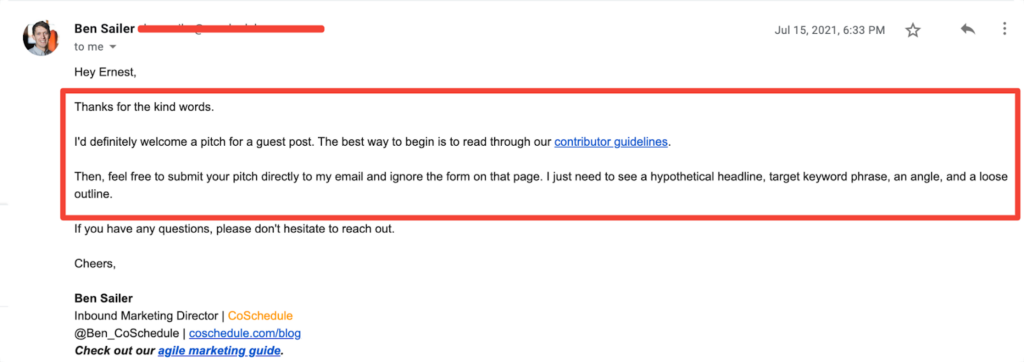
Here is another successful example from a similar strategy.

First, they love the cold emails, and tell us they did love them. Then offer to hire us to work with them. Dope!
Note: The icebreakers are also part of the pre-campaign content we keep in our spreadsheets. Here is what it looks like.
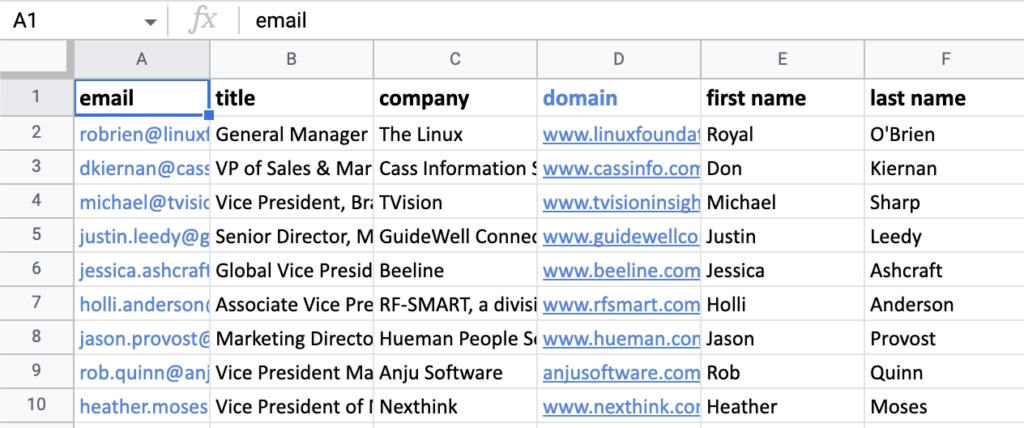
Step 5: Create personalized subject lines
From our experience, when someone opens your cold emails, we believe one of the following three scenarios has happened.
- They know you.
- Someone introduced you.
- You caught their attention.
Since we are talking about cold emails and generating B2B leads, the third is where we land.
Creating click-worthy subject lines is a must for the success of our cold emails. It is the first thing the reader sees in the email, so it’s essential to make it compelling. We want to grab the reader’s attention and make them want to open the email.
Ideally, we want something brief, specific, and relevant to the reader. Here are some tips we use for this.
- Personalization: Poorly written subject lines will leave your email unanswered. We like our prospects to know that we specifically researched and targeted them with an offer for them. You can personalize the subject line with prospects’ first names based on their job title, demographics, software uses, etc.
- Curiosity: Curious people always want to learn more. Doing this helps get the reader excited about what we want to say. You can ask an intriguing question. Bring out a relevant fact. The sky’s the limit.
- FOMO: This is all about creating a sense of urgency to get prospects to act rapidly. If you do it right, people will click to see what you have to say or offer them. No one likes to miss out on something valuable.
- Simple: No all caps, no exclamation points (unless you’re asking someone out on a date). These are quick ways to get your emails flagged by spam filters and end up in the junk box.
Step 6: Craft a compelling, personalized cold email
We don’t believe in sending many emails to get meager results. Also, personalization is your only chance of winning in this game.
When writing cold emails, our primary strategy is to make the message about the prospects’ pain points.
We are trying to show them that we are not just blasting them with random emails. We are trying to convince them that our offer is unique and targeted to them.
In our experience, mentioning their paint points makes our cold emails valuable and our offer relevant to them.
So, we consider prospects’ pain points and needs as the starting point. We take a look at the challenges they face and how we can help them. We also consider their business goals and how our service fits into that.
Based on that, we then develop specific use cases of our service that will be relevant to them in their unique situation. From there, we proceed to write the value section in your email body as follows:
- Use cases: Unique situations where the offering will be the most meaningful and relatable to the reader. It covers their pain points or aligns with their business or lifestyle goals.
- Benefits: We demonstrate how adopting the offering will impact their life by reading the email body. The value we are bringing to their table or the lifestyle they will have after integrating the product or using our service.
- Examples: Real-life case scenario of our service in action or how it has done the same for someone with the same need and goals as the prospect.
This approach helps the reader quickly understand the value we are offering and why they should be interested.
We like to use bullet points and numbered lists to do this. It’ll also help to make our cold email copy email more readable and easier to scan.
Here’s an example. In this cold email, we pitched a Head of Marketing at a B2B Marketing Agency and focused on their specific pain point.

And here’s his reply.

We then make sure the email is well-written and end it with a clear call to action. Also, in our books, no two prospects are the same.
Every potential customer is different and faces unique challenges. For example, two prospects might need the same tool, but you can close both by highlighting the same features.
Because of this, we study each of our prospects and create a unique cold email for everyone.
That’s how we are able to get great results.
Step 7: Send, track, analyze, and follow up
By this time, we have everything figured out and ready to go. We ensure our copy is compelling, load everything in our email marketing software, and make sure it is the best time to send our cold emails, and kick off the campaign.
Next, we track and analyze the results to measure our campaign’s success or explain the lack thereof. So, we track email open, positive answers, prospects needing follow-ups, and the deals close — aka conversion.
And for the leads who engaged with our cold emails and showed some interest but didn’t take any action, we follow-up. In most cases, our follow-up process is to handle their potential objections, provide more value about what we offer, and more.
Finally, we continuously refine the process based on the results we get and how the prospects engage with our campaigns, considering factors such as response, open, and conversion rates.
Why you need to work with Nerdy Joe for your B2B lead generation needs
Here are a couple of reasons you need to work with our agency to generate B2B leads.
Pay for results — not the number of emails we send
Ask or look around. You’ll find four types of lead generation agencies:
- Those that charge you are based on the number of emails they send or contacts they put in your list.
- Those that charge you a monthly fee and promise you’ll get the best leads ever but never deliver on their promise.
- Those who call everyone who’s downloaded an ebook or PDF a LEAD charge you for that.
- Those that charge based on the number of QUALIFIED leads they generate for your sales team.
Given your needs, you should only care about those who charge based on results. And at Nerdy Joe, we live and breathe client ROI (return on investment).
When we start working with clients, we always make it clear that the prospect list we build and the number of emails we send are not their business.
The number #1 pain point of a company that needs help with lead generation is that they need LEADS. So, we get you leads and charge you for that — not for our work.
Our prospecting and lead generation strategies are performed manually to insure quality and accuracy — so you get qualified leads
As we explained, we are crazy about data quality and personalized targeting.
Manually building our list is how we ensure that. It helps ensure that we get you qualified leads, and your company won’t have to worry about the cost of data intelligence tools or compliance issues.
We won’t make you sign any contract — you can renew or stop your subscription based on satisfaction.
Most people are stuck into 3-6 or 12-month contracts with their lead gen agencies that barely get them any results. It’s costing you a lot of money, you are not getting what you want, and you can’t walk back on the agreement; we feel you.
That’s why we require no contracts. You choose what you want; we get it for you. You are happy; we take pride in that, and both parties are satisfied.
We don’t play hide and seek — you know & get exactly what you pay for
Our offerings and pricing are clear — and this is probably why we’re one of the best lead generation agencies. You choose a plan based on your budget and needs and know exactly what you get at the end of the month.
- No, “it depends on a lot of factors.”
- No, “Your account manager swallowed the key to his office and couldn’t work.”
- No “BS”
As long as you have product-market fit and are solving a genuine problem that your ICP has and cares to solve, it is almost everything we need to get you results. But if you’re still figuring out who your solution is best for, then we’re probably not going to help.
Our lead generation service’s pricing is crystal clear. We have three plans:

- Silver: It costs $499/month and only gives you one warm LEAD.
- Gold: This is the plan we recommend, as it gives you the biggest bang for your buck. It costs $999/month and gives you six hot and sales-qualified appointments or LEADS.
- Platinum: This plan is for mid-level to enterprise companies willing to fuel their sales team with up to 15 sales-ready leads every month.
Our pricing also includes the following:
- The tech stack we use to build your prospect list and send and monitor your campaign.
- A complete list of prospects that fit your buyer persona and ICP.
- The campaign setup fees.
Get leads to your digital marketing agency with Nerdy Joe
If you need leads from your digital marketing agency, you can reach out to us, and we will use our proven process and strategy to land you marketing gigs. All you have to do is hop on a call to clause your deals.
If you have a valuable marketing strategy that you think companies can benefit from, you can work with us. We’ll help you with a stellar cold email campaign that’ll help you get unprecedented results. You’ve seen how we did it and got positive results.
We can do the same for you, plus we’ll ensure you have a good from the get-go with excellent messaging and super-personalization for your brand. We’ll ensure you impress them and get to their hearts from the cold emails.
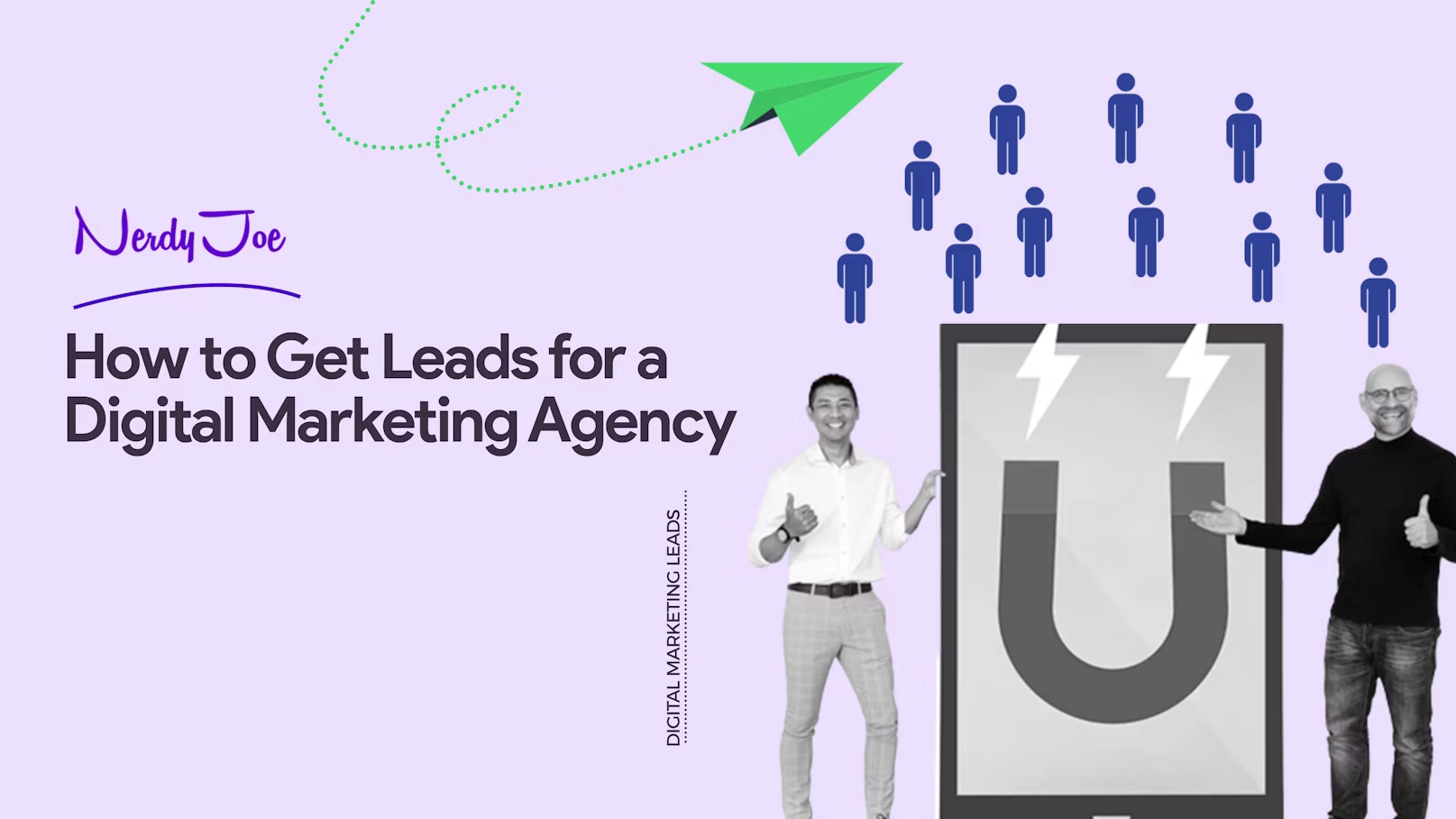
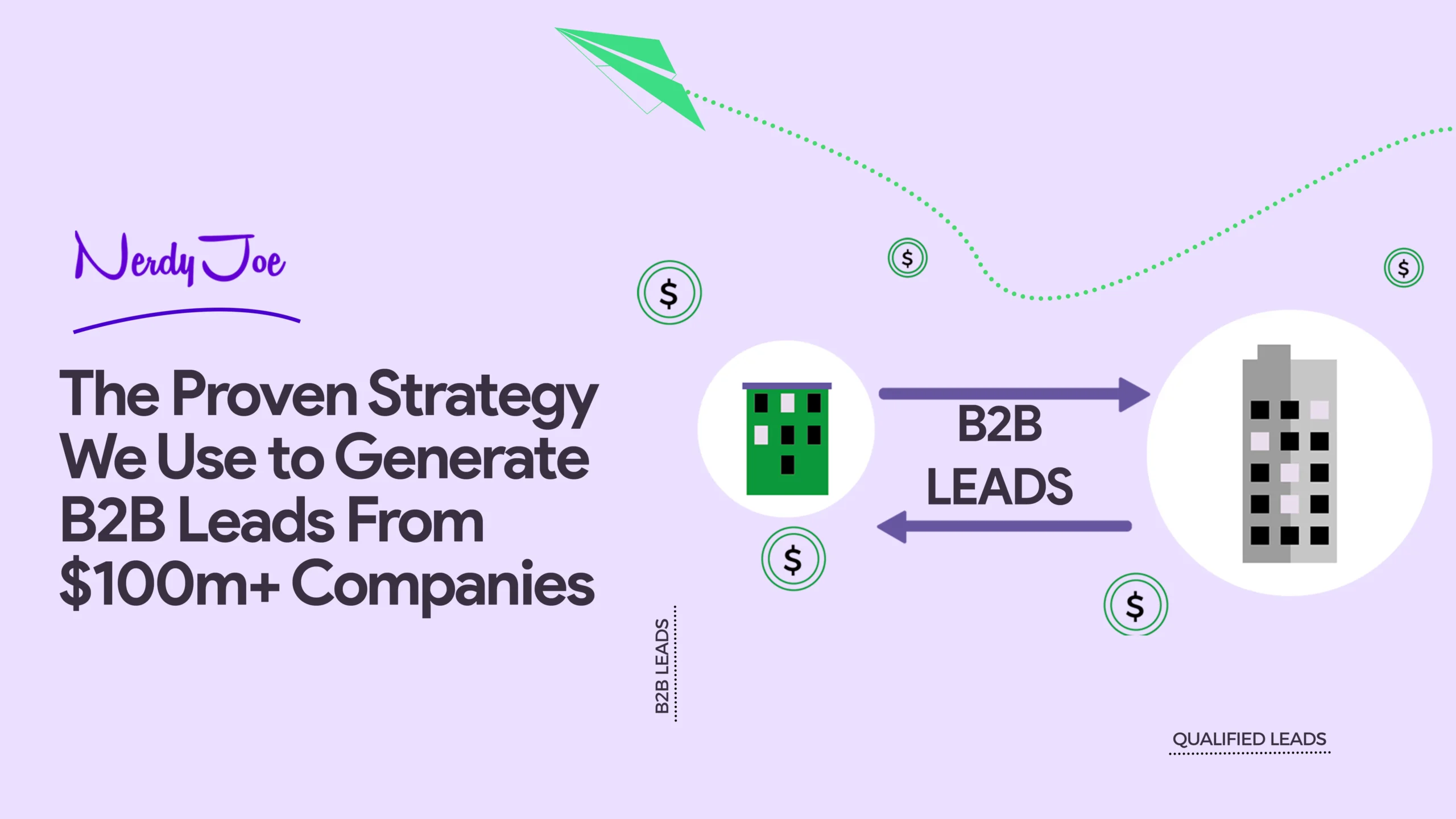
![How to Generate B2B Leads With Cold Outreach [Case Study]](https://nerdyjoe.com/wp-content/uploads/2024/06/1669218674-artboard-1-copie-4-3x-1-scaled.webp)
